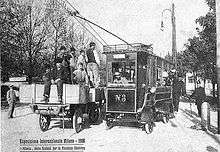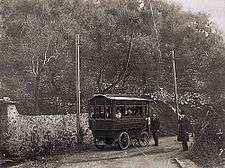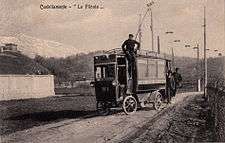Cantono Frigerio system
The Cantono Frigerio system was an Italian electric power supply for trackless trolleybuses with two wires about 20 inches (50 cm) apart being contacted by a four-wheeled collector on a single trolley pole. In English publications it was often described as Filovia system although the Italian term filovia means literally wire way, i.e. a trolleybus line or a trolleybus system.

History

Werner Siemens introduced the first collector for trackless vehicles with his Electromote cart in 1882, and in 1901 Max Schiemann demonstrated sliding contact shoes, which were pressed by springs against the overhead wires. Five years later Eugenio Cantono from Rome combined these two principles and exhibited six trolleybuses at the world's fair Milan International, 1906.
The power supply differed from those in other countries in that, as a collector, a four-wheeled truck ran underneath the wires, held in place by a trolley pole in the usual manner. The possible deviation on either side of the direct route was 10–12 feet (3.0 to 3.5 m). The cars were usually equipped with two 15-horsepower (11 kW) motors and had a carrying capacity of 20 to 24 passengers.[1] Its design and construction have been so perfected that it would take easily very sharp curves, and would not leave the trolley wires even when running at a speed of 18 miles per hour (29 km/h). They could master larger grades than trams, it was claimed.[2] The overhead wires had a diameter of ⅜ inches (9 mm) for 600 Volt direct current and could be used in both directions. The drivers stood upright in a cab similar to that of a tram.
Cantono was supported by the Fabbrica Rotabili Avantreni Motori (F.R.A.M.) in Genoa, which he had founded, and by the Società per la Trazione Elettrica in Milano, which produced Frigerio branded cars. This led to the term Cantono Frigerio system.
The system was very successful in Italy, where trackless trolley lines were very highly regarded in the first quarter of the 20th century. A total of more than 50 miles (80 km) of line were in use to the satisfaction of the municipalities by 1916. In some cities subsidies were paid for establishing such lines.[1]
Systems
| Line | Dates | Picture | Comments |
|---|---|---|---|
| Pescara–Castellammare Adriatico | 1903 to 1904 |  | The first trolleybuses of Italy ran on the route at Castellammare Adriatico. The line was opened in 1903. The trolleybusses were equipped with the Cantono Frigerio system, with two 550 V direct current motors and a noisy rear axle chain drive. They had solid rubber tyres and a maximum speed of 15 miles per hour (25 km/h).[3] |
| La Spezia–Porto Venere | 1906 to 1908 |  | The line from La Spezia to Fezzano was opened on 10 February 1906 and offered 20 return trips per day. After initial praise, the capacity turned out to be insufficient, and larger cars would have been required. The operation was hampered by the rough track and regular derailments of the collector trolley. There were reoccurring problems with the brakes and the electrical insulation of the vehicles. Therefore, the council of La Spezia decided in 1908 to build a tram to Cadimare, which replaced the trolleybus in November 1909.[4] |
| Milan | 1906 |  | The Società per la Trazione Elettrica demonstrated at the Milan International Exposition, 1906 from 28 April to 11 November 1906 the benefits of the system on a circular track around the exhibition centre on Piazza d'Armi.[5] |
| Siena | 1907 to 1920 | .jpg) | Trolleybuses were commissioned in Siena on 24 March 1907. The approximately 4.5 miles (7 km) long line connected Fontebecci and Valli with the city (Piazza Indipendenza) and the railway station. It was initially operated by the Società Imprese Elettriche Senesi (SIES), which was later renamed to Società Anonima Filovie Senesi (SAFS). The narrow and steep streets in the town caused difficulties, so that the company was liquidated on 13 April 1920.[6] |
| Ivrea–Cuorgnè | 1908 to 1935 |  | The line from Ivrea to Cuorgnè was built according to plans of the surveyor Vallino. It was opened on 30 March 1908. It had the nickname Filovia del Poeta (Poet's line) because it passed the house of the poet Giuseppe Giacosa. It offered initially a very satisfactory service, but was replaced by buses, when passenger numbers increased at the end of the 1920s. |
| Cuneo | 1908 -? | The construction of the line in Cuneo began in April 1908. In June 1908 it was tested and then officially opened on 1 August 1908 from the new church to the railway station. The cars, which had been exhibited in Milan were used up to 1926. The last section of the line was closed in 1968, but may have no longer used this single pole system.[7][8] | |
| Argegno–San Fedele Intelvi | 1909 to 1922 | The Filovia Valle d'Intelvi from Argegno at lake of Como to San Fedele Intelvi was operated from 4 July 1909 to end of 1922.[9] It climbed up a steep zig-zag-road with a gradient of up to 11% or 13%.[10] | |
| L’Aquila | 1909 to 1924 | .jpg) | The L'Aquila Città Filovia was operated from 1909 to 1924. |
| Alba–Barolo | 1910 to 1919 | .jpg) | The line from Alba to Barolo was planned and built by the Società per la Trazione Elettrica in Mailand and operated by the Società Filovia Albesi. It was opened on 26 September 1910 and decommissioned in 1919 due to significant technical problems.[11] |
| Enego–Primolano | 1915 to 1918[12] | ._Agosto_1917.jpg) | Most Italian trolleybus lines were used not only for transporting passengers but also goods. The military line from Enego Primolano was opened in 1910 for transporting goods and especially ammunition. |
| Edolo–Ponte di Legno | 1915 to 1918[12] | The military line from Edolo to Ponte di Legno transported mainly goods and ammunition. | |
| Marostica–Puffele | 1916 to 1919[12] |  | During World War I, the military line from Marostica Puffele was used for transporting goods and ammunition.[13] |
| Breganze–Turcio | Approx. 1916 | The military line from Breganze to Turcio was used mainly for transporting ammunition during World War I.[13] |
See also
References
- Cyclopedia of applied electricity - a general reference work on direct-current generators and motors, storage batteries, electrochemistry, welding, electric wiring, meters, electric lighting, electric. 1916. Page 399, on-line. (English)
- Railless Traction at Bradford, Light Railway and Tramway Journal, 7 April 1911. (English)
- Gabriele Montella: Il filobus. (Italian)
- Francesco Ogliari, Franco Sapi, Signori, in vettura! Storia dei trasporti italiani vol. 5. Liguria, a cura degli autori, Milan, 1965. pp. 130, 133, 134 und 155. (Italian)
- Milanoneisecoli: La prima filovia di Milano. (Italian)
- Maura Martellucci und Roberto Cresti: Pillole quotidiane di storia senese: 24 marzo 1907: la filovia a Siena. (Italian)
- Francesco Ogliari und Franco Sapi: Scintille fra i monti. Storia dei trasporti italiani. Volumes 8° und 9°. Piemonte-Valle d'Aosta, a cura degli autori, Mailand, 1968. (Italian)
- Paolo Gregoris, Francesco Rizzoli und Claudio Serra: Giro d'Italia in Filobus, Calosci - Cortona, 2003, S. 42–46. ISBN 8877851937. (Italian)
- Un secolo di trasporti: dalla filovia all’autobus ecologico. (Italian)
- Hawera & Normanby Star, Band LX, 23. September 1910, Seite 3, und on-line. (English)
- Paolo Gregoris, Francesco Rizzoli, Claudio Serra, Giro d'Italia in filobus, Calosci - Cortona, 2003, S. 14. ISBN 8877851937. (Italian)
- Mattis Schindler: Übersicht Obusbetriebe der Welt. Issued on July 2010. (English and German)
- Scan of a book im Mondo Tram Forum. (Italian)
External links
